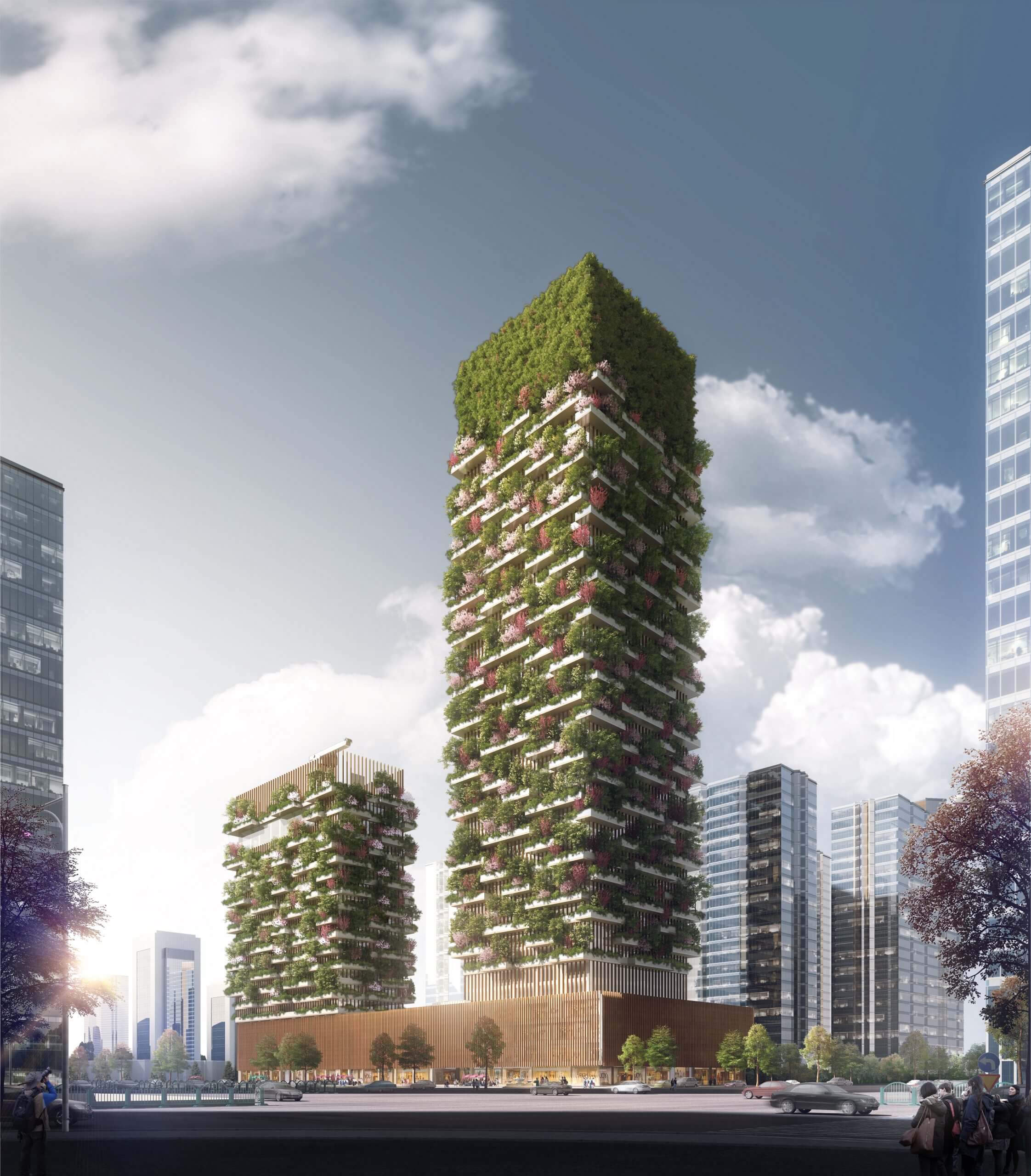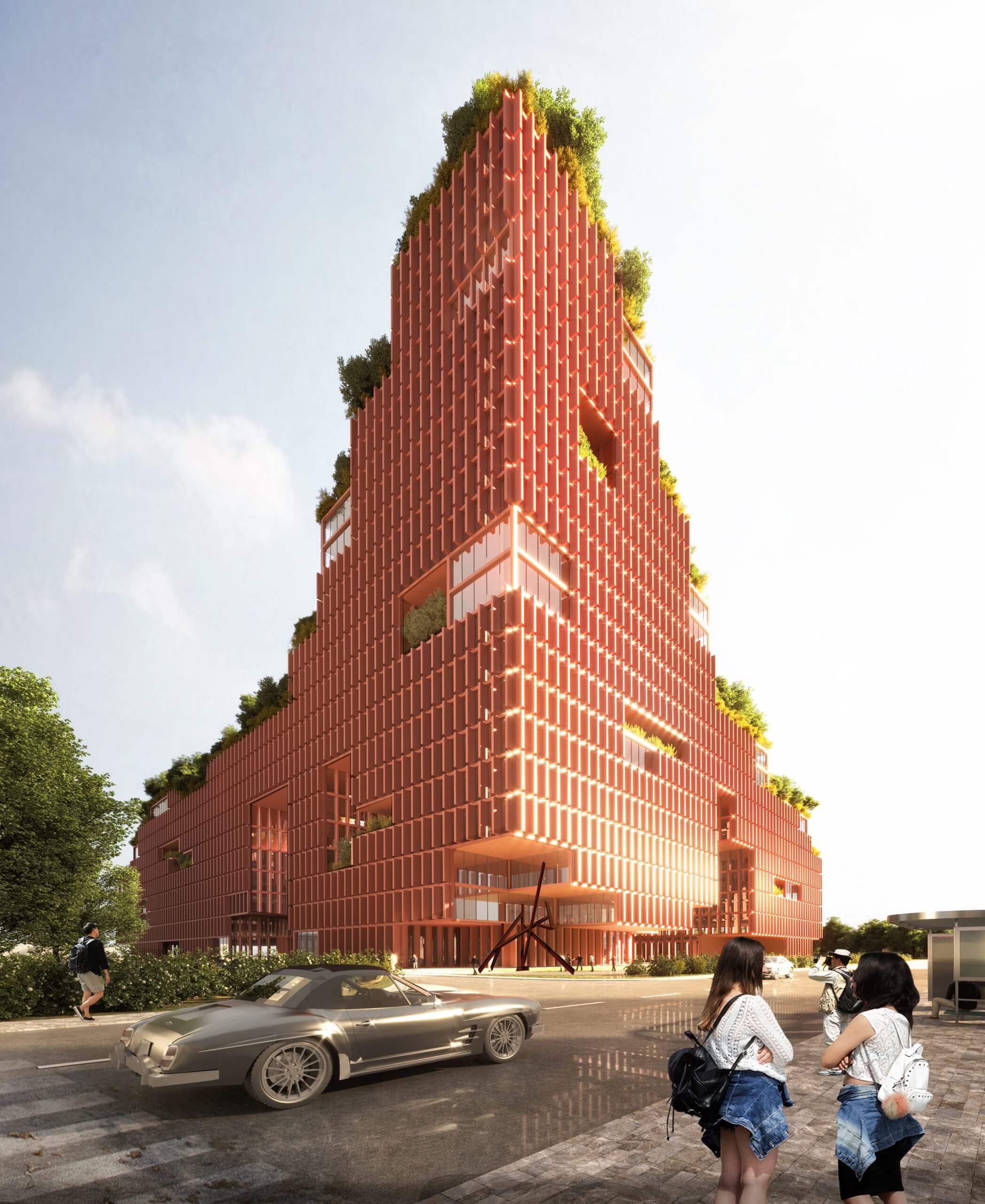Between Biodiversity and Architecture: Stefano Boeri

“If the virus has closed us in hospitals and homes, the vaccine will finally bring us back into contact with social life and with the nature that surrounds us”. Says Stefano Boeri (b. Milan, 1956), Italian architect, urban planner and architectural theorist, in raising awareness for the national communication campaign for the anti-COVID-19 vaccine in Italy.
Based in Milan, but also in Shanghai and Tirana, Stefano Boeri Architetti Studio is active all over the world with numerous projects whose prerogative associates architecture with nature: a requirement that seems to become a new reality, especially in densely-packed cities. A reality that inevitably, due to the pandemic, involves a further change: a necessary adaptation of life into society. Among the projects contributing to a type of sustainable architecture (some are still under construction), are the Vertical Forest and the Smart Forest City in Cancun, Mexico.
Boeri has served as the director of the Milan Triennale since 2018. He has exhibited works at the Venice Biennale, the Chengdu Biennale, Beijing Design Week, the Milan International Furniture Fair, the Musée d’Art Moderne de la Ville de Paris and at the Kunst-Werke Institute for Contemporary Art in Berlin. He’s carried out redevelopment projects in the ports of Napoli, Marseille, Genoa and urban redevelopment interventions in Rome, São Paulo, Venice, Moscow and Qingdao, to name a few. More recently, Boeri defeated COVID-19, himself.
Boeri tells FRONTRUNNER about his most important projects and his post-pandemic vision between architecture and a modus vivendi.

Vertical Forest: Nanjing
Artist’s rendering
Photo credit: Stefano Boeri Architetti (Milano/Shanghai/Tirana)
Today, more than ever, urban planning is synonymous with sustainability: cities increasingly immersed in architecture with biodiversity. One of your first projects was the Bosco Verticale (Vertical Forest) project carried out in the Porta Nuova district of Milan. How was that carried out?
The idea of building a tower completely surrounded by trees was conceived in early 2007 in Dubai – one of the cradles of new oil and financial capitalism. I was a director of Domus, the frenetic construction of a city in the desert made up of dozens of new towers and skyscrapers, all clad in glass, ceramic and metal. All reflect sunlight and, therefore, heat generators: in the air and especially on urban public land. During those months, I started a project for two tall towers in the center of Milan and suddenly – the most radical and bizarre ideas come without warning – it occurred to me to build two biological towers. Two towers covered not with glass, but with leaves. Plants, shrubs, but especially tree leaves. Two towers lined with life.
Considering the costs – maintenance, in particular – isn’t this type of architecture likely to be only for the elite? An exclusive kind, accessible to a few?
After the first Vertical Forest in Milan – which also owes its cost to the initial investment in research – we worked with great obstinacy on the construction systems (prefabrication) and materials needed to make the Vertical Forest accessible to all. We succeeded. In recent weeks, we will complete the Trudo Vertical Forest in Eindhoven, a residential social housing building. The green tower is intended to mainly accommodate popular users, in particular young couples, hosting in its 19 floors a series of rent-controlled apartments with high living quality. Thanks are also due to as many as 125 trees of various species on the balconies, to which about 5,200 shrubs and smaller plants will be added. A Vertical Forest is accessible to all, which applies this model to social housing for the first time. Also in China, in Hangguang (Hubei region), we are about to complete two residential towers with thousands of plants on the facades that will be put on the market at controlled prices.
In China, your studio is located in Shanghai. There, you designed the first forest city in the world. To date, what has been the feedback from this project, and in general, how has your studio’s work changed due to the pandemic?
Liuzhou was one of the first forest city projects. After being approved by the municipality, it was blocked by the new administration. But we are working, not only in China, on other foundation cities where plants and trees play a fundamental role. The most important is the Smart Forest City of Cancun, Mexico: a real forest city that can host more than 7 million trees and combines the principles of urban forestry with those of energy self-sufficiency. But in addition to forest-cities, our studio is engaged in large forestry projects for existing cities. Today, more than ever, we’ve realized that our cities need plants, trees, and greenery not only to absorb CO2 and clean the air we breathe, but also to find a balance between living species. The loss of biodiversity is, among other things, one of the best conditions for the jump of virus species such as COVID-19. We must understand that it is necessary to rewrite our relationship with plant and animal nature from the ground up, to consider them both no longer in terms of exploitation but of a new alliance.
You are also the president of the Milan Triennale: urban planning, art and politics. Realities that can lead to the creation of a network between companies, cities and the redevelopment of spaces, especially in the suburbs. What must be the right prerogative today for the common good to operate at its best? And why.
Imagining the future has become an arduous exercise with the pandemic. It’s as if we were anchored to a gloomy present that leaves us no respite and forces us to debase, day after day, the most precious habits of our being together. But this difficult experience can become an opportunity to rethink the logic and forms of urban life at the root; to imagine a planet crossed by great corridors of biodiversity. Forests and cities find a new balance, historic villages return to being communities of life, and metropolises become archipelagos of self-sufficient neighborhoods. A new world that can arise from an intelligent acceleration of trends is already underway.

Shenzen Rehabilitation Center
Artist’s rendering
Photo credit: Stefano Boeri Architetti (Milano/Shanghai/Tirana)
What is the right compromise between design and innovation?
Any innovation, even the most radical, arises from an unstable balance between technological research, respect for present conditions, and the legacy of the past and traditions. The invention of the Vertical Forest is certainly an act of great discontinuity in the spheres of architecture and urban planning, but it would never have been possible without the intuition of the Italian Radicals, the projects of Hundertwasser in Vienna, the work of the Sites in the US, and the visions of the artist Joseph Beuys.
How was the temporary architectural and communicative concept of the COVID-19 vaccination campaign conceived?
Our proposal associates the vaccination campaign with a flower, an icon not only of the great biodiversity present in the Italian territory, but a symbol of the cycle of nature and continuous rebirth. Thanks to the image of a primrose, the first spring flower after a long winter, we wanted to offer a sign of serenity and regeneration. If the virus had closed us in hospitals and homes, the vaccine will finally bring us back into contact with social life, and with the nature that surrounds us. Getting vaccinated will, therefore, be a step of trust in the future, of civil responsibility and of love for others.
Due to the pandemic, our modus vivendi has changed in terms of style, but above all in terms of priorities. In your opinion, how should cities, public and private spaces of the future be? How should they adapt to a reality that, even when everything is over, will inevitably leave indelible traces?
We will have to learn to de-synchronize the time of urban life, to rethink open spaces and domestic ones, to radically change the system of mobility. Also, to encourage the use of renewable energy, create green architecture, rebuild a reciprocal relationship with thousands of abandoned villages, and enhance biodiversity by implementing our heritage of woods and forests. For some time, we should have thought about the effects of an aggressive, superficial, invasive and overbearing attitude on the natural balance that contained the contributing causes of the pandemic. Cities must become active nodes of ecological corridors. [They must] absorb quotas of nature and become part of an environmental, economic and productive system integrated with protected wooded, mountainous and agricultural areas, capable of protecting their biodiversity.
Speaking of de-synchronizing the time of urban life, the island of Procida has been proclaimed Capital of Culture 2022 in Italy. It’s an opportunity for recovery in terms of art, tourism (not just the local economy, but the national one.) What are your impressions?
I am very happy with the appointment of Procida as Capital of Culture 2022. I love the Italian and Mediterranean islands because I believe they preserve, often more than the coastal territories, the deep soul of the Mediterranean.

What projects are you currently working on?
We have numerous active shipyards in China and Europe. We are completing the construction of Vertical Forests in Eindhoven, Antwerp, Utrecht, Tirana, Nanjing and Huanggang. And many others – again in China, Italy, Holland, Belgium and Albania – are in the executive planning stage. In Shenzhen we are building the largest rehabilitation center in China; a green building designed to be accessible to all disabilities. For the Albanian capital, we’ve recently designed Tirana Riverside, the first high-performing district from a seismic point of view, capable of responding to contemporary housing needs and all the sustainability requirements required by the pandemic crisis.
What is the “winning secret” for an international studio like yours?
On the one hand, certainly the obstinacy in trying to promote a new generation of tall and green architectures, where green is not an ornament but a fundamental element of architecture. Also, the effort to make them better and better: accessible to all, [made from] wood, smart, self-sufficient from an energy point of view. On the other hand, a continuous curiosity towards the vibrations and tensions that arise in disciplinary fields that are very distant from ours such as botany, astrophysics, oceanography, research on dark matter and micro-particles. Our studio has learned to give concrete form to dreams and gravity to more abstract ideas.











Responses